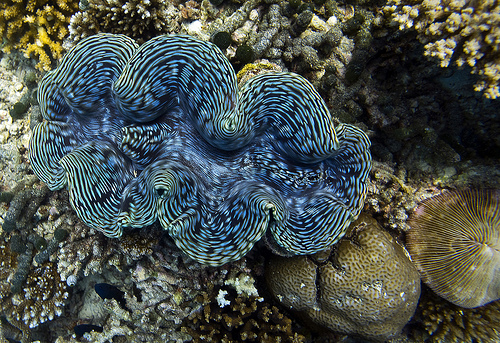You may not be a giant when next to a giant clam.
- Giant clams are very large bivalves, shells with two pieces that are hinged together, and are native to the Indian and Pacific oceans, in coral reefs.
- The giant clam has the scientific name Tridacna gigas, and is a mollusc from the family Cardiidae, the family of cockles, and it is commonly believed to be the largest extant bivalve, and while it is the heaviest, longer specimens of Kuphus polythalamia have been found.
- Giant clams typically range from 90 to 120 centimetres (35 to 47 inches) in length, and can weigh 100 to 200 kilograms (220 to 440 pounds), although they can grow larger.
- The diet of a giant clam primarily consists of nutrients produced by algae that the clam plays host to and with which it lives in a photosymbiosis relationship, and it also consumes plankton and sometimes other plant and animal matter.
- Giant clams possibly grow around 12 centimetres in length annually, until maximum length has been reached, and they have a lifespan spanning approximately 20 to 100 years in the wild.
Giant Clam
Image courtesy of Malcolm Browne/Flickr
- Once a giant clam has found a favourable location, it settles there and does not re-position itself ever again, however, they do have predators, that include eels; fish; starfish; and snails, that are smaller than the clam itself, and once attacked, they will be slowly eaten by their enemies.
- Giant clams are vulnerably endangered due to coral reef habitat destruction as well as over-fishing partly due to the clam being considered as a delicacy.
- Giant clams usually close in self defense, but quite slowly, and often not all the way, and while they have often been regarded as highly dangerous and fatal, this is considered a myth and no known fatalities have occurred.
- Giant clams have a combination of colours that vary, and include yellow, red, orange, green, pink, blue and brown, and it is said that every clam is unique in its appearance.
- Giant clams are said to be able to produce 500 million eggs at once, that are released in the ocean and once fertilised, they quickly hatch and produce a shell.
Bibliography:
Giant Clam, 2013, A-Z Animals, http://a-z-animals.com/animals/giant-clam/
Giant Clam, 2014, National Geographic, http://animals.nationalgeographic.com.au/animals/invertebrates/giant-clam/
Giant Clam, 2014, Wikipedia, http://en.wikipedia.org/wiki/Giant_clam







